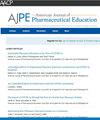NAPLEX实践分析和确定初级药剂师的知识和技能。
IF 3.5
4区 教育学
Q1 EDUCATION, SCIENTIFIC DISCIPLINES
引用次数: 0
摘要
目的:描述一个实践分析的结果,定义的知识,技能,和能力的预期入门级药剂师和开发的结果NAPLEX内容大纲。方法:全国药学委员会协会召集了一个具有代表性的药剂师小组(N=14),创建了一个实践分析文件(PAD)和CO。在这个过程中使用了小组经验、当前NAPLEX能力陈述和指导性文件。对执业药师的大样本进行了调查,以验证CO并确定每个域的最终权重。受访者在李克特量表上选择了最低内容领域水平的相关性评级(1=完全不相关;4 =非常相关)。调查结果用于制定最终的CO,该CO由NABP批准,以指导NAPLEX的开发。结果:创建了一个PAD,列出了五个内容域以及与每个域相关的任务、知识和技能。一千九百五十名药剂师全部或部分完成了调查,并对每个内容领域的最低水平提供了相关性评分(N=54)。平均相关性评分为3.25 (SD=0.42,范围2.22至3.85),表明每个内容领域与实践的相关性很高。最后创建了一个CO,用于定义要在NAPLEX上评估的内容区域。结论:实践分析过程为确定初级药师的期望知识、技能和能力提供了宝贵的资源。教育工作者可以利用这些资源为毕业生准备全国教育方案。本文章由计算机程序翻译,如有差异,请以英文原文为准。
NAPLEX Practice Analysis and Determining the Knowledge and Skills Expected of an Entry-Level Pharmacist
Objective
To describe the results of a practice analysis defining the knowledge, skills, and abilities expected of entry-level pharmacists and the development of the resultant North American Pharmacist Licensure Examination (NAPLEX) content outline (CO).
Methods
The National Association of Boards of Pharmacy convened a representative panel of pharmacists (n = 14) to create a practice analysis document and CO. Panel experience, current NAPLEX competency statements, and guiding documents were used in the process. A survey was administered to a large sample of practicing pharmacists to validate the CO and determine final weights for each domain. Respondents selected a relevance rating for the lowest content domain level on a four-point Likert scale (1 = not at all relevant; 4 = very relevant). Survey results were used to develop the final CO, which was approved by the National Association of Boards of Pharmacy to guide NAPLEX development.
Results
A practice analysis document was created listing 5 content domains along with the tasks, knowledge, and skills associated with each domain. A total of 1950 pharmacists fully or partially completed the survey and provided relevance ratings for the lowest level of each content domain (n = 54). The mean relevance rating was 3.25 (SD = 0.42; range 2.22 to 3.85), indicating a high degree of relevance for each content domain to practice. A final CO was created, which is used to define content areas to be assessed on the NAPLEX.
Conclusion
A practice analysis process produced valuable resources for defining the expected knowledge, skills, and abilities for entry-level pharmacists. These resources can be utilized by educators to prepare graduates for the NAPLEX.
求助全文
通过发布文献求助,成功后即可免费获取论文全文。
去求助
来源期刊
CiteScore
4.30
自引率
15.20%
发文量
114
期刊介绍:
The Journal accepts unsolicited manuscripts that have not been published and are not under consideration for publication elsewhere. The Journal only considers material related to pharmaceutical education for publication. Authors must prepare manuscripts to conform to the Journal style (Author Instructions). All manuscripts are subject to peer review and approval by the editor prior to acceptance for publication. Reviewers are assigned by the editor with the advice of the editorial board as needed. Manuscripts are submitted and processed online (Submit a Manuscript) using Editorial Manager, an online manuscript tracking system that facilitates communication between the editorial office, editor, associate editors, reviewers, and authors.
After a manuscript is accepted, it is scheduled for publication in an upcoming issue of the Journal. All manuscripts are formatted and copyedited, and returned to the author for review and approval of the changes. Approximately 2 weeks prior to publication, the author receives an electronic proof of the article for final review and approval. Authors are not assessed page charges for publication.

 求助内容:
求助内容: 应助结果提醒方式:
应助结果提醒方式:


